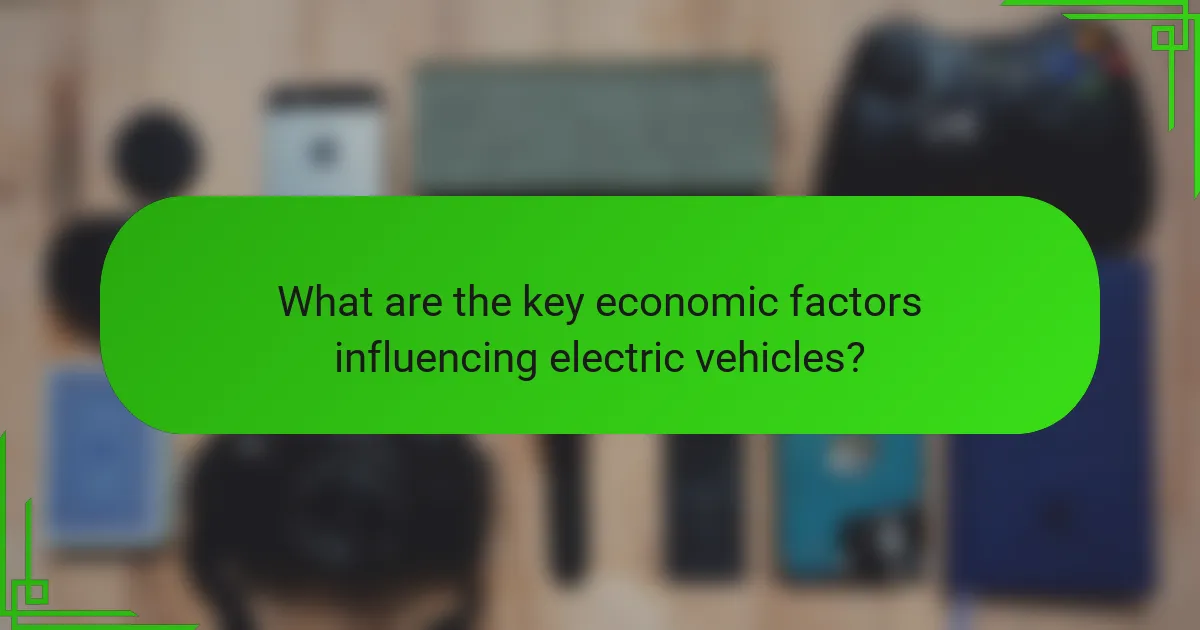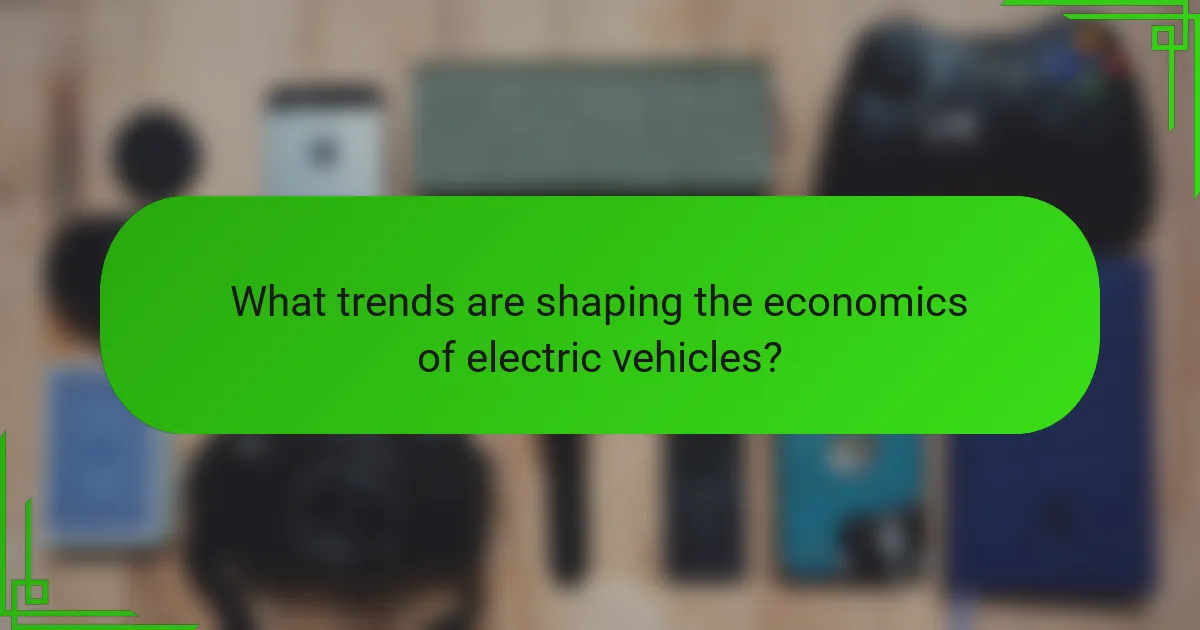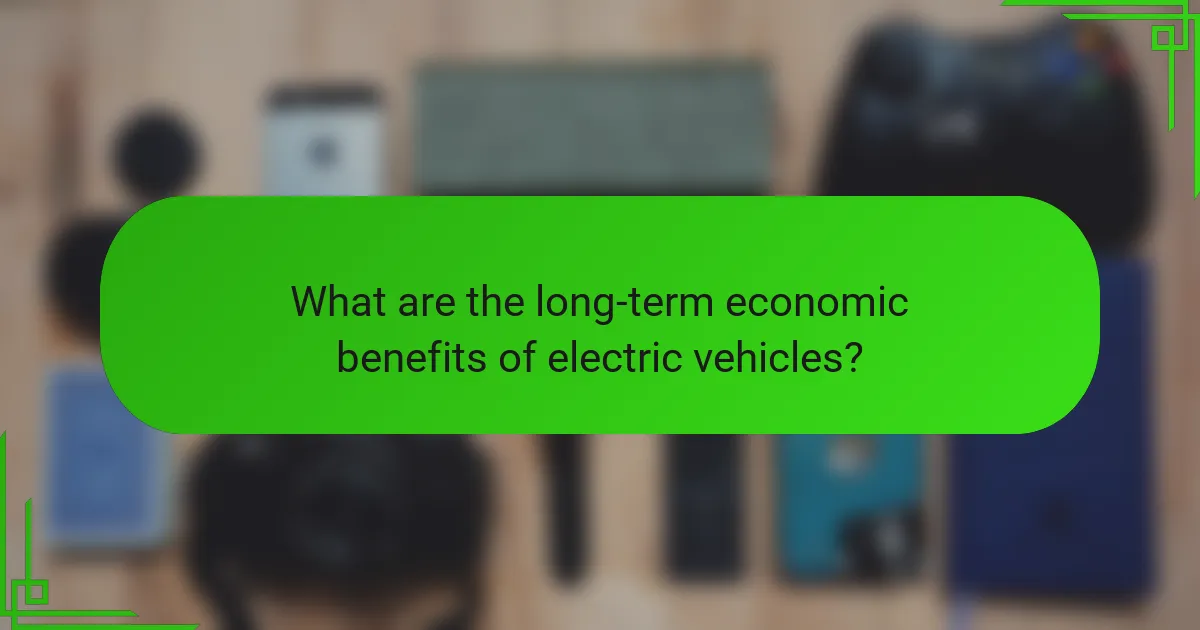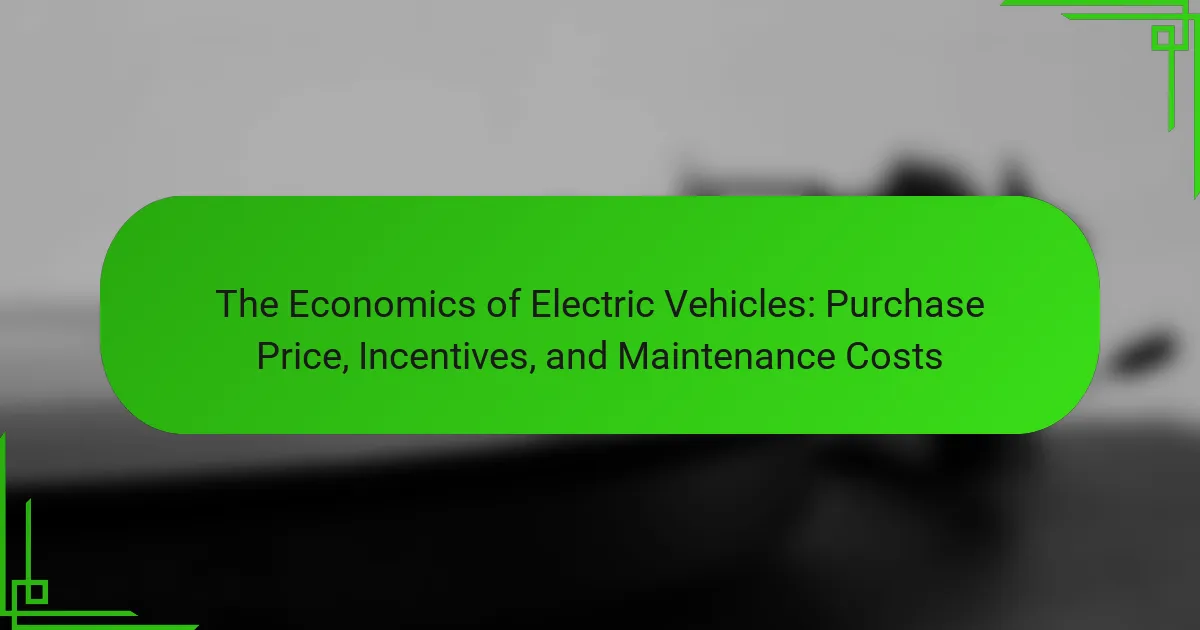Electric vehicles (EVs) are increasingly becoming a focal point in discussions about modern transportation economics. Key economic factors influencing EV adoption include purchase price, government incentives, and maintenance costs. While the initial purchase price of EVs is generally higher than that of traditional vehicles, advancements in battery technology are driving prices down. Government incentives, such as tax credits and rebates, enhance affordability and stimulate consumer interest. Additionally, lower maintenance costs and the expanding charging infrastructure contribute to the overall economic viability of electric vehicles, making them a more attractive option for consumers. As fuel prices rise and technology improves, the economic landscape for EVs continues to evolve, presenting significant long-term benefits.

What are the key economic factors influencing electric vehicles?
Key economic factors influencing electric vehicles include purchase price, government incentives, and maintenance costs. The purchase price of electric vehicles is generally higher than that of traditional vehicles. However, prices are decreasing due to advancements in battery technology. Government incentives significantly impact electric vehicle adoption. Many countries offer tax credits or rebates for electric vehicle purchases. Maintenance costs for electric vehicles are typically lower than for internal combustion engine vehicles. Electric vehicles have fewer moving parts, leading to reduced repair costs. Additionally, the cost of electricity compared to gasoline affects overall operating expenses. As charging infrastructure expands, the convenience and accessibility of electric vehicles improve, influencing consumer choices.
How does the purchase price of electric vehicles compare to traditional vehicles?
Electric vehicles (EVs) typically have a higher purchase price than traditional vehicles. For example, as of 2023, the average price of a new electric vehicle in the U.S. is around $66,000, compared to approximately $48,000 for a conventional gasoline car. This price difference is primarily due to the cost of battery technology. Batteries account for a significant portion of an EV’s total cost. However, the total cost of ownership can be lower for EVs due to savings on fuel and maintenance. Government incentives can also reduce the effective purchase price of EVs, making them more competitive.
What factors contribute to the purchase price of electric vehicles?
The purchase price of electric vehicles is influenced by several key factors. Battery technology significantly affects the cost. High-capacity batteries are expensive, impacting overall vehicle pricing. Manufacturing processes also play a role. Advanced production techniques can increase costs. Supply chain logistics are crucial as well. Transportation and material sourcing influence final pricing. Government incentives can lower effective purchase prices. Tax credits and rebates reduce out-of-pocket expenses for consumers. Market demand affects pricing too. High demand can lead to increased prices. Finally, brand reputation and features contribute to variations in purchase price. Premium brands often command higher prices due to perceived quality and technology.
How do electric vehicle prices vary by model and manufacturer?
Electric vehicle prices significantly vary by model and manufacturer. Factors influencing these prices include battery capacity, range, and features. For instance, Tesla models typically range from $40,000 to over $100,000. In contrast, more affordable options like the Nissan Leaf start around $28,000. Luxury brands like Audi and Porsche offer electric models that can exceed $100,000. Government incentives also impact pricing, providing rebates that can reduce costs by several thousand dollars. Market demand and production costs further contribute to price variations across different manufacturers and models.
What incentives are available for purchasing electric vehicles?
Incentives for purchasing electric vehicles include federal tax credits, state rebates, and local incentives. The federal government offers a tax credit up to $7,500 for eligible electric vehicles. Many states provide additional rebates ranging from $1,000 to $5,000. Some local governments offer incentives like reduced registration fees or access to carpool lanes. Utility companies may provide rebates for home charging station installations. As of 2023, over 40 states have some form of incentive for electric vehicle buyers. These incentives aim to reduce the overall cost and encourage the adoption of electric vehicles.
What federal tax credits can electric vehicle buyers access?
Electric vehicle buyers can access the federal tax credit under the Qualified Plug-in Electric Drive Motor Vehicle Credit. This credit can provide up to $7,500 based on the battery capacity of the vehicle. The amount of the credit decreases once a manufacturer sells 200,000 qualifying vehicles. Buyers must purchase a new, qualified electric vehicle to be eligible. The credit is claimed when filing federal taxes. The IRS provides guidelines on eligible vehicles and the application process. This program aims to encourage the adoption of electric vehicles and reduce greenhouse gas emissions.
How do state and local incentives affect electric vehicle purchases?
State and local incentives significantly influence electric vehicle purchases by reducing the overall cost for consumers. These incentives can take the form of tax credits, rebates, and grants. For example, federal tax credits can offer up to $7,500 off the purchase price. Additionally, some states provide their own rebates that can further decrease costs. Local incentives may include reduced registration fees or access to carpool lanes. According to a study by the International Council on Clean Transportation, these financial incentives can increase electric vehicle adoption by up to 40%. Overall, state and local incentives make electric vehicles more financially accessible, encouraging higher sales.
What are the maintenance costs associated with electric vehicles?
Maintenance costs associated with electric vehicles (EVs) are generally lower than those for traditional gasoline vehicles. EVs have fewer moving parts, which reduces the likelihood of mechanical failure. Regular maintenance typically includes tire rotations, brake inspections, and battery checks. According to a 2021 study by the U.S. Department of Energy, EV maintenance costs average about $500 per year. This is significantly lower than the approximately $1,200 average for gasoline vehicles. Additionally, EVs do not require oil changes, which further decreases maintenance expenses. Overall, the lower maintenance costs are a key financial advantage of owning an electric vehicle.
How do maintenance costs of electric vehicles compare to traditional vehicles?
Maintenance costs of electric vehicles (EVs) are generally lower than those of traditional vehicles. EVs have fewer moving parts, which reduces the need for maintenance. For example, they do not require oil changes, and brake wear is minimized due to regenerative braking. According to a study by Consumer Reports, EV owners can save an average of $4,600 over ten years on maintenance compared to gasoline vehicles. Additionally, the absence of complex internal combustion engines leads to fewer mechanical issues. Overall, the lower maintenance needs of electric vehicles contribute to their cost-effectiveness over time.
What specific maintenance needs do electric vehicles have?
Electric vehicles (EVs) have specific maintenance needs that differ from traditional vehicles. Key maintenance requirements include battery health monitoring. The battery is a critical component, and its performance impacts range and efficiency. Regular software updates are essential for optimal performance. These updates can enhance vehicle functionality and safety features. Tire maintenance is also important due to the weight distribution in EVs. Proper tire pressure and alignment can improve efficiency. Brake system checks are necessary as EVs use regenerative braking, which can affect brake wear patterns. Additionally, coolant levels for battery temperature regulation must be monitored. Overall, while EVs require less frequent maintenance than combustion engines, specific areas demand attention.

What trends are shaping the economics of electric vehicles?
The economics of electric vehicles (EVs) are shaped by several key trends. First, the decreasing cost of battery technology significantly lowers overall vehicle prices. According to BloombergNEF, battery prices fell by 89% from 2010 to 2020. Second, government incentives and subsidies enhance affordability for consumers. Many countries offer tax credits and rebates to encourage EV adoption. Third, the expanding charging infrastructure increases convenience and reduces range anxiety for potential buyers. As of 2023, the U.S. has over 100,000 public charging stations. Fourth, rising fuel prices make EVs more economically attractive compared to traditional vehicles. In 2022, gasoline prices surged, prompting consumers to consider electric alternatives. Lastly, advancements in EV technology improve performance and reduce maintenance costs. Electric vehicles typically have fewer moving parts, leading to lower long-term expenses. These trends collectively create a more favorable economic environment for electric vehicles.
How is the market demand for electric vehicles changing?
Market demand for electric vehicles (EVs) is increasing significantly. In 2023, global EV sales rose by 55% compared to 2022. This surge is driven by growing environmental concerns and government incentives. Many countries are implementing stricter emissions regulations, encouraging consumers to switch to EVs. Additionally, advancements in battery technology are improving EV range and reducing costs. For instance, the average price of EV batteries dropped by 9% in 2022. Consumer awareness and acceptance of EVs are also rising. A recent survey indicated that 60% of potential car buyers are considering an EV. Overall, the market demand for electric vehicles is on an upward trajectory, influenced by multiple economic and social factors.
What role do government policies play in the electric vehicle market?
Government policies significantly influence the electric vehicle market. They shape consumer behavior through incentives such as tax credits and rebates. For instance, the U.S. federal tax credit offers up to $7,500 off the purchase price of eligible electric vehicles. This financial support encourages more consumers to consider electric vehicles over traditional ones.
Additionally, government regulations on emissions drive manufacturers to invest in electric vehicle technology. For example, California’s strict emissions standards push automakers to increase their electric vehicle offerings. This regulatory environment fosters innovation and competition within the market.
Furthermore, investments in charging infrastructure by governments enhance the viability of electric vehicles. Studies show that increased charging stations correlate with higher electric vehicle adoption rates. In summary, government policies create a framework that promotes electric vehicle adoption through financial incentives, regulatory pressures, and infrastructure development.

What are the long-term economic benefits of electric vehicles?
Electric vehicles (EVs) offer significant long-term economic benefits. They reduce fuel costs since electricity is generally cheaper than gasoline. According to the U.S. Department of Energy, EV owners can save an average of $800 annually on fuel. EVs also have lower maintenance costs due to fewer moving parts compared to internal combustion engine vehicles. The maintenance cost for EVs can be 30% less over the vehicle’s lifetime.
Additionally, EVs can increase energy independence by reducing reliance on imported oil. This shift contributes to national economic stability. Governments often provide tax incentives and rebates for EV purchases, further lowering the initial cost. According to the International Council on Clean Transportation, these incentives can average $7,000 per vehicle.
Furthermore, the widespread adoption of EVs can stimulate job growth in green technology sectors. A study by the University of California found that transitioning to electric vehicles could create 1.1 million jobs by 2030. Overall, the long-term economic benefits of electric vehicles include fuel savings, lower maintenance costs, energy independence, financial incentives, and job creation.
How do electric vehicles impact overall cost of ownership?
Electric vehicles (EVs) significantly impact the overall cost of ownership by reducing fuel and maintenance expenses. EVs typically have lower energy costs compared to gasoline vehicles. According to the U.S. Department of Energy, the cost to drive an electric vehicle is about half that of a conventional car.
Maintenance costs are also lower for EVs due to fewer moving parts. Electric motors require less frequent servicing than internal combustion engines. For instance, EVs do not need oil changes, which can save substantial amounts over time.
In addition, many governments offer incentives for EV purchases. These incentives can include tax credits, rebates, and grants that lower the initial purchase price. For example, the federal tax credit in the U.S. can be up to $7,500, depending on the vehicle.
Overall, while the initial purchase price of EVs may be higher, long-term savings in fuel and maintenance can lead to a lower total cost of ownership.
What savings can owners expect on fuel costs?
Owners of electric vehicles can expect significant savings on fuel costs compared to traditional gasoline vehicles. Electric vehicles typically cost about $0.03 to $0.05 per mile to operate, while gasoline vehicles average around $0.10 to $0.15 per mile. This means that electric vehicle owners can save approximately 50% on fuel costs. For example, if an electric vehicle is driven 12,000 miles annually, the fuel cost could be about $360 to $600, compared to $1,200 to $1,800 for gasoline vehicles. Additionally, the U.S. Department of Energy reports that electric vehicles can be three to five times more efficient than gasoline vehicles. This efficiency translates into lower overall fuel expenses for owners.
How do electric vehicles affect resale value over time?
Electric vehicles typically depreciate at a slower rate than traditional vehicles. This trend is influenced by increasing demand for used electric vehicles. Factors such as government incentives and lower operating costs enhance their appeal. According to a 2021 study by Edmunds, electric vehicles retained about 50% of their value after three years. In comparison, conventional vehicles retained only about 39% during the same period. Battery life and technology improvements also contribute to better resale values. As charging infrastructure expands, consumer confidence in electric vehicles grows. This shift positively impacts their resale market over time.
What environmental and social benefits do electric vehicles provide?
Electric vehicles (EVs) provide significant environmental and social benefits. They reduce greenhouse gas emissions, contributing to cleaner air and combating climate change. According to the U.S. Environmental Protection Agency, EVs produce zero tailpipe emissions. This leads to improved air quality, which can reduce respiratory diseases and health issues related to pollution.
EVs also decrease dependence on fossil fuels, promoting energy independence. They utilize renewable energy sources, which can further lower overall emissions. A study by the International Energy Agency indicates that EV adoption can lead to a 30% reduction in oil demand by 2040.
Socially, electric vehicles promote job creation in the green technology sector. The transition to EVs supports industries focused on renewable energy and battery production. Furthermore, EVs can lead to lower operating costs for consumers, enhancing economic stability.
In summary, electric vehicles offer environmental benefits through reduced emissions and improved air quality, while also providing social advantages by creating jobs and reducing energy costs.
How do electric vehicles contribute to reducing carbon emissions?
Electric vehicles contribute to reducing carbon emissions by producing zero tailpipe emissions during operation. This means they do not emit carbon dioxide or other greenhouse gases while being driven. Additionally, when charged using renewable energy sources, electric vehicles further decrease their overall carbon footprint. A study by the Union of Concerned Scientists indicates that electric vehicles can reduce emissions by 50% or more compared to gasoline vehicles, depending on the energy mix used for charging. The shift from fossil fuels to electricity in transportation is a key factor in lowering overall emissions.
What is the impact of electric vehicles on local economies?
Electric vehicles positively impact local economies by creating jobs and stimulating local businesses. The production and maintenance of electric vehicles require skilled workers, leading to job creation in manufacturing and service sectors. Local governments benefit from increased tax revenues due to the growth of electric vehicle infrastructure. Additionally, electric vehicles contribute to reduced fuel costs for consumers. This savings can be redirected into the local economy, boosting other sectors. Studies show that regions with electric vehicle initiatives experience economic growth. For instance, a report from the International Council on Clean Transportation found that electric vehicle adoption can lead to a net economic benefit of $1.3 billion in the U.S. by 2030.
What practical tips can help consumers navigate electric vehicle economics?
Consumers can navigate electric vehicle economics by researching available incentives and rebates. Many governments offer tax credits for electric vehicle purchases. For example, the U.S. federal tax credit can be up to $7,500. Understanding total cost of ownership is crucial. This includes purchase price, maintenance costs, and fuel savings. Electric vehicles typically have lower maintenance costs due to fewer moving parts. Consumers should also consider charging options. Home charging can save money compared to public charging stations. Comparing different models helps identify the best value. Tools like cost calculators can provide personalized estimates based on usage patterns.
The main entity of this article is electric vehicles (EVs), with a focus on their purchase price, incentives, and maintenance costs. The article examines key economic factors influencing EV adoption, including the higher initial purchase price compared to traditional vehicles, the impact of government incentives such as tax credits and rebates, and the generally lower maintenance costs associated with EV ownership. It also highlights trends shaping the EV market, such as advancements in battery technology and the expansion of charging infrastructure, while discussing the long-term economic benefits and environmental advantages of transitioning to electric vehicles.




